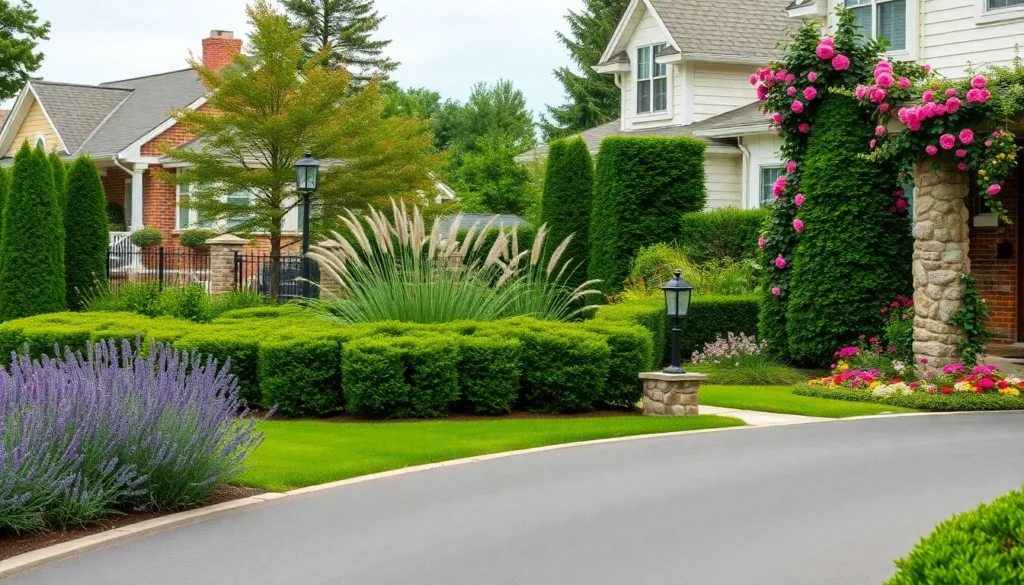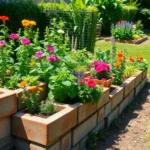We’ve all driven past those stunning homes where the front garden and driveway work together like a perfectly choreographed dance. The truth is creating that same harmonious balance between functionality and beauty isn’t as complicated as you might think. With the right approach your front yard can become the neighborhood showstopper that makes every visitor stop and stare.
Today’s homeowners face unique challenges when designing their front gardens around existing driveways. Whether you’re working with a long straight drive a curved pathway or a compact urban space we understand the struggle of maximizing curb appeal while maintaining practical access to your home.
We’re about to share game-changing front garden ideas that’ll transform your driveway from a boring necessity into an integral part of your industry design. From low-maintenance plant selections to creative hardscaping answers these proven strategies will help you create an entrance that welcomes guests and adds serious value to your property.
Create a Welcoming Entrance With Defined Borders
Well-defined borders transform your front garden into an organized, professional-looking industry that guides visitors naturally toward your entrance.
Use Low Hedging to Separate Garden From Driveway
Boxwood hedging creates the most popular boundary solution for front gardens with driveways. We recommend planting these evergreen shrubs 12 to 18 inches apart to form a continuous, manicured edge that stays green year-round. Dwarf varieties like Buxus sempervirens ‘Suffruticosa’ reach only 12 to 24 inches in height, making them perfect for maintaining clear sightlines while providing structure.
Lavender borders offer aromatic appeal alongside visual definition between garden beds and paved surfaces. Plant these Mediterranean herbs 18 to 24 inches apart for optimal growth and air circulation. Purple-flowered varieties like Lavandula angustifolia ‘Hidcote’ bloom from June through August, attracting beneficial pollinators while releasing fragrant oils when brushed against.
Ornamental grasses provide movement and texture as natural driveway separators throughout changing seasons. Fountain grass (Pennisetum alopecuroides) and feather reed grass (Calamagrostis x acutiflora) create soft, flowing boundaries that contrast beautifully with hard paving materials. Space these perennial grasses 24 to 36 inches apart to allow for their mature spread.
Install Decorative Edging Materials
Natural stone edging delivers timeless elegance that complements both traditional and contemporary home styles. Limestone, sandstone, or granite blocks create permanent borders that require minimal maintenance once installed. Set stones 2 to 4 inches below ground level and backfill with gravel for proper drainage and stability.
Metal industry edging provides clean, modern lines that work exceptionally well with geometric garden designs. Steel or aluminum strips bend easily around curved driveways while maintaining crisp edges between grass and planted areas. Install these materials 3 to 4 inches deep with proper anchoring stakes every 3 feet for secure placement.
Brick or paver borders echo driveway materials for cohesive design flow throughout your front industry. Lay these hardscape elements in single or double rows, setting them flush with ground level or slightly raised for enhanced definition. Choose colors and textures that coordinate with your home’s exterior materials for maximum visual impact.
Add Structured Planting Along Driveway Edges
Evergreen foundation plantings anchor your driveway borders with year-round color and consistent structure. Rhododendrons, azaleas, and pieris provide spring blooms followed by dense foliage that frames your entrance beautifully. Plant these shrubs 3 to 5 feet from pavement edges to prevent root damage and allow for mature growth.
Seasonal color displays brighten driveway plantings with rotating annual flowers that change throughout growing seasons. Spring tulips and daffodils give way to summer marigolds and petunias, followed by fall mums and ornamental kale. Plan these succession plantings in dedicated beds 18 to 24 inches wide for easy access and maintenance.
Architectural specimen plants serve as focal points that draw attention to your entrance while providing vertical interest. Japanese maples, ornamental crabapples, or columnar evergreens create stunning centerpieces when positioned strategically near driveway curves or entrance gates. Space these statement plants at least 8 to 10 feet apart to showcase their individual characteristics.
Design Symmetrical Plantings for Classic Appeal
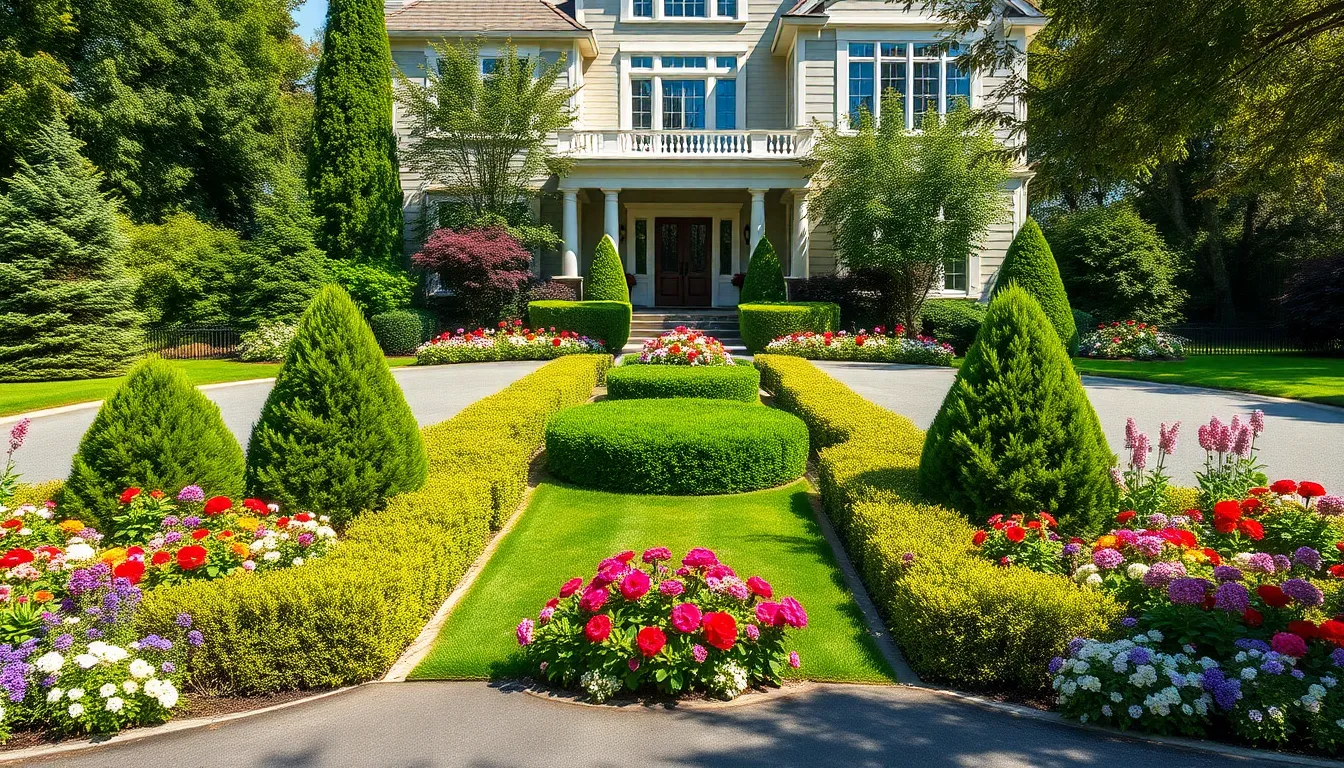
Symmetrical design creates instant elegance and transforms any driveway entrance into a sophisticated focal point that enhances your home’s architectural features.
Plant Matching Shrubs on Both Sides
Matching shrubs create visual balance by anchoring your driveway with identical plantings that frame the entrance beautifully. We recommend selecting evergreen varieties like boxwood, juniper, or dwarf spruces that maintain their structure year-round and provide consistent color throughout all seasons.
Position these shrubs at equal distances from the driveway’s edge to establish perfect symmetry. Consider the mature size of each plant to ensure they won’t outgrow their designated space or obstruct vehicle access over time.
Maintain consistent spacing between multiple shrubs on each side to create rhythm and flow. Choose varieties with similar growth rates and pruning requirements to keep maintenance simple and ensure both sides develop uniformly.
Create Mirror Image Flower Beds
Mirror image flower beds establish formal beauty by replicating identical planting schemes on opposite sides of your driveway entrance. Start by measuring and marking equal-sized planting areas that complement your driveway’s width and your home’s proportions.
Select flowers with similar bloom times and heights to maintain consistent visual impact throughout the growing season. Popular combinations include white roses with purple lavender, red geraniums with silver dusty miller, or yellow marigolds with blue salvias.
Layer plants by height with taller specimens in the back and shorter ones in front to create depth and ensure all flowers remain visible. Use the same number of each plant variety in both beds to achieve perfect symmetry that enhances your property’s curb appeal.
Use Geometric Shapes for Formal Gardens
Geometric shapes bring structure and sophistication to front garden designs by creating defined patterns that complement architectural elements. Circles, rectangles, and diamond shapes work particularly well when constructed with grass, gravel, or decorative stone materials.
Create circular planting beds at the entrance corners using materials like brick edging or metal borders to define clean lines. Fill these geometric spaces with low-growing plants like ornamental grasses or seasonal flowers that won’t obscure the shape’s definition.
Rectangular patterns work exceptionally well for linear driveways by echoing the straight lines of paved surfaces. Use contrasting materials such as light-colored gravel against dark mulch or smooth river rocks against textured bark to emphasize geometric boundaries and create visual interest.
Incorporate Vertical Elements for Added Height
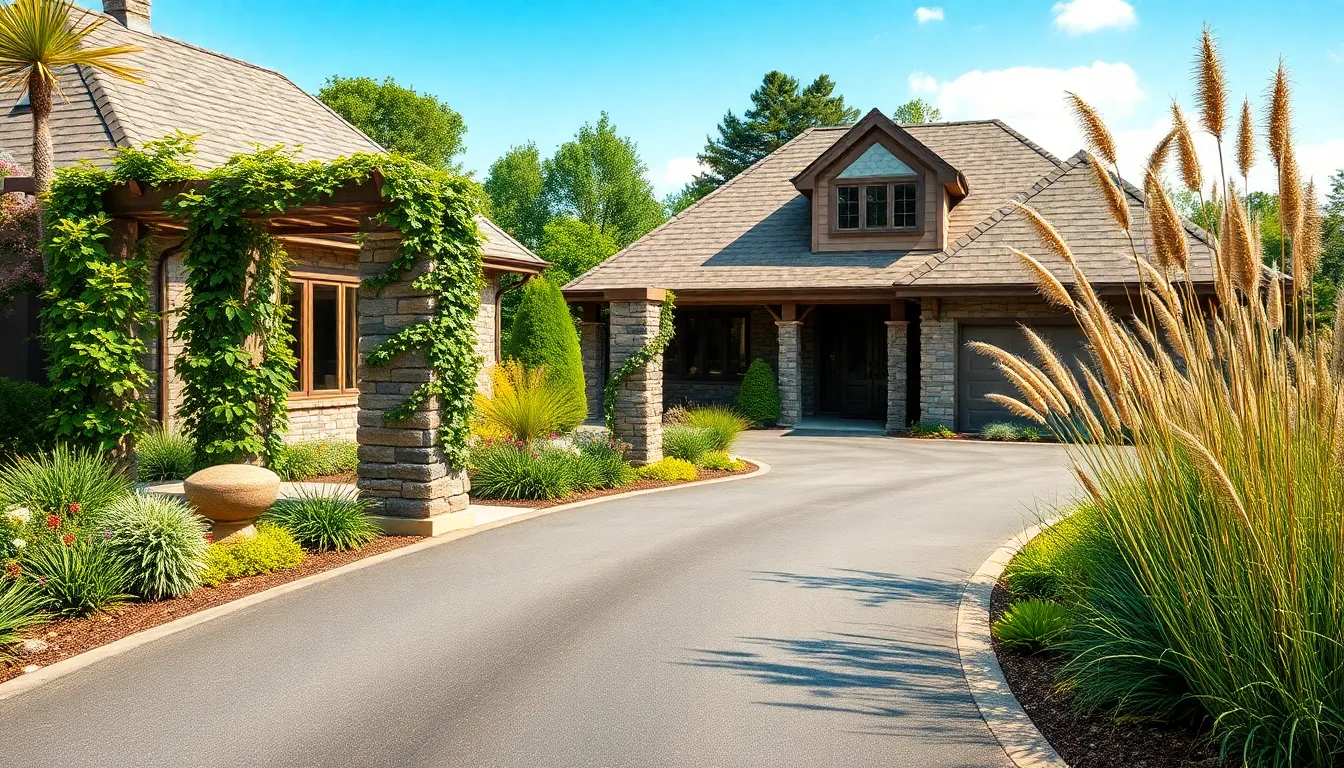
Creating visual interest in your front garden with driveway requires strategic use of vertical elements that draw the eye upward. We’ll explore three effective approaches that add dimension and elegance to your driveway industry.
Install Decorative Posts or Pillars
Installing decorative posts or pillars brings instant elegance to your front garden entrance. We recommend positioning these structures at key points along your driveway to create natural focal points that guide visitors toward your home. Decorative posts can serve dual purposes by supporting climbing plants or framing your driveway entrance with architectural distinction.
Stone pillars offer timeless appeal and complement various home styles, while wooden posts provide rustic charm that works well with cottage or farmhouse aesthetics. Metal options deliver contemporary sophistication that pairs beautifully with modern driveways. We suggest spacing posts evenly to maintain visual balance and proportion throughout your garden design.
Add Climbing Plants on Trellises
Adding climbing plants on trellises creates lush, green backdrops that transform ordinary driveway spaces. We’ve found that roses, clematis, and ivy work exceptionally well for creating beautiful vertical gardens that enhance any driveway setting. Trellises provide essential support structure while adding their own decorative appeal to your industry design.
Positioning trellises against walls or fences maximizes growing space without encroaching on driveway functionality. We recommend selecting climbing varieties that match your garden’s maintenance requirements and seasonal preferences. Annual climbers like morning glories offer quick coverage, while perennial options such as climbing hydrangeas provide long term structure and beauty.
Use Tall Ornamental Grasses
Using tall ornamental grasses such as pampas grass or fountain grass adds texture and movement to your driveway flower bed. We create layered looks by positioning these grasses strategically behind shorter varieties, establishing natural height gradation that enhances visual depth. Ornamental grasses provide year round interest with their changing seasonal colors and graceful movement in breezes.
Fountain grass offers manageable height with elegant arching forms that soften hard driveway edges. Pampas grass delivers dramatic impact with its towering plumes that create stunning focal points. We suggest grouping grasses in odd numbers for natural appeal and combining different textures to maximize visual interest throughout your front garden design.
Choose Low-Maintenance Ground Cover Options
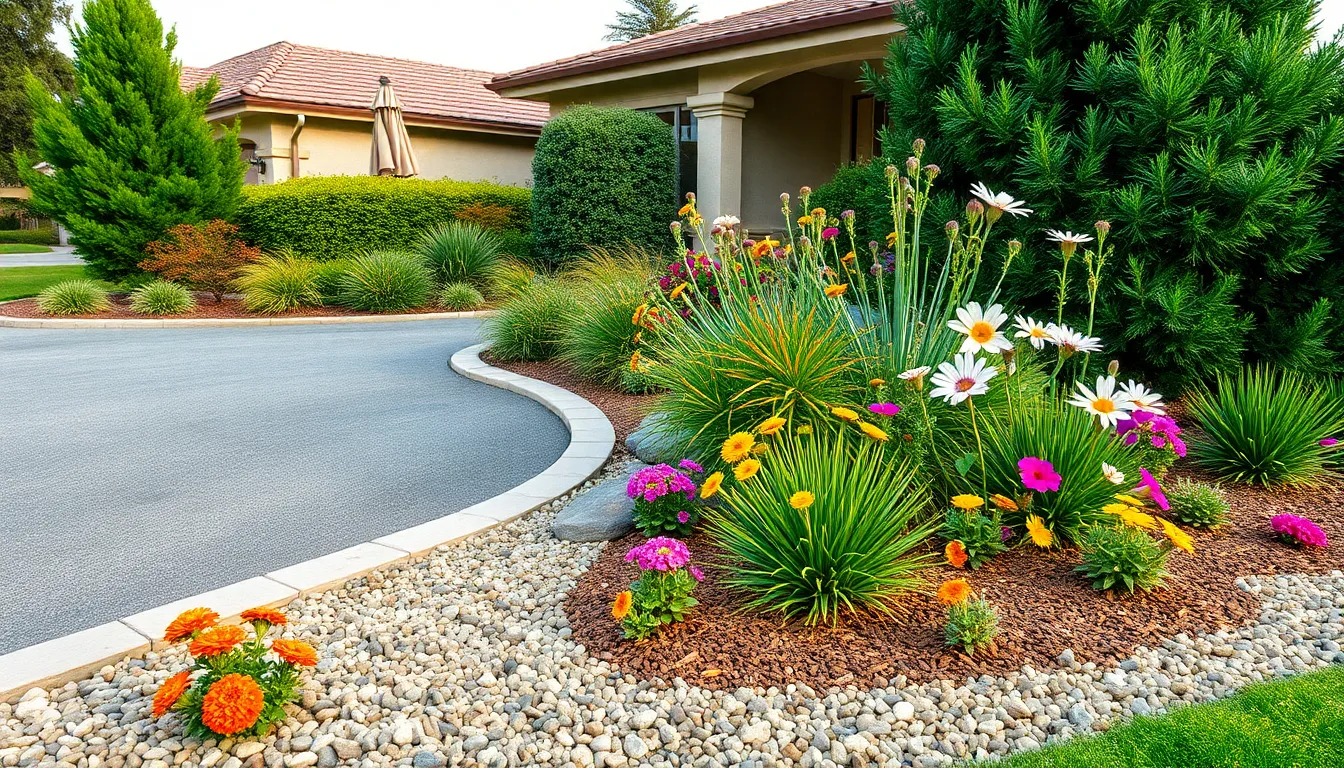
Creating stunning front garden landscapes doesn’t have to mean hours of weekly maintenance. We’ll explore ground cover answers that complement your driveway while requiring minimal upkeep throughout the seasons.
Select Drought-Tolerant Plants
Drought-tolerant plants form the backbone of any sustainable front garden design. Ornamental grasses like black mondo grass, corkscrew grass, and blue oat grass add texture and movement while thriving with minimal water requirements. These varieties create natural flow between your driveway and garden beds without demanding constant attention.
Evergreen shrubs such as boxwood and holly deliver year-round color and structure alongside your driveway. They establish reliable framework that withstands seasonal changes while requiring less frequent watering than traditional flowering plants. Creeping thyme and sedum varieties spread naturally across ground areas, creating living carpets that suppress weeds and fill spaces between hardscaping elements.
Succulents offer bold architectural interest in regions with minimal rainfall. We recommend clustering different varieties to create textural contrast while maintaining the water-wise approach that makes these plants ideal for busy homeowners.
Use Decorative Gravel or Mulch
Decorative gravel transforms ordinary ground cover into visually appealing design elements. This material provides excellent drainage around driveway edges while reducing maintenance needs compared to traditional grass areas. Different gravel sizes and colors create patterns that complement your home’s exterior palette.
Mulch retains soil moisture naturally while suppressing weed growth throughout growing seasons. Organic options like shredded bark or wood chips break down slowly, enriching soil as they decompose. Inorganic materials such as rubber mulch or stone chips offer longer-lasting coverage with consistent appearance year after year.
Both options reduce watering requirements significantly while creating clean transitions between planted areas and driveway surfaces. Strategic placement around specimen plants highlights their importance while maintaining cohesive design flow.
Plant Native Species for Easy Care
Native plants adapt naturally to local climate conditions without requiring extensive care or resources. Species like black-eyed susans and prairie dropseed thrive in Cincinnati’s climate while supporting local ecosystems and wildlife populations. These selections eliminate guesswork about water needs and seasonal care requirements.
Native grasses blend seamlessly with surrounding environments while establishing deep root systems that prevent erosion near driveway edges. They require minimal fertilization and pest control compared to non-native alternatives, making them perfect choices for sustainable industry design.
Regional native species create authentic connections between your front garden and the broader natural industry. We find that these plants establish quickly and maintain consistent appearance with far less intervention than exotic varieties that struggle in unfamiliar growing conditions.
Add Functional Lighting for Safety and Style
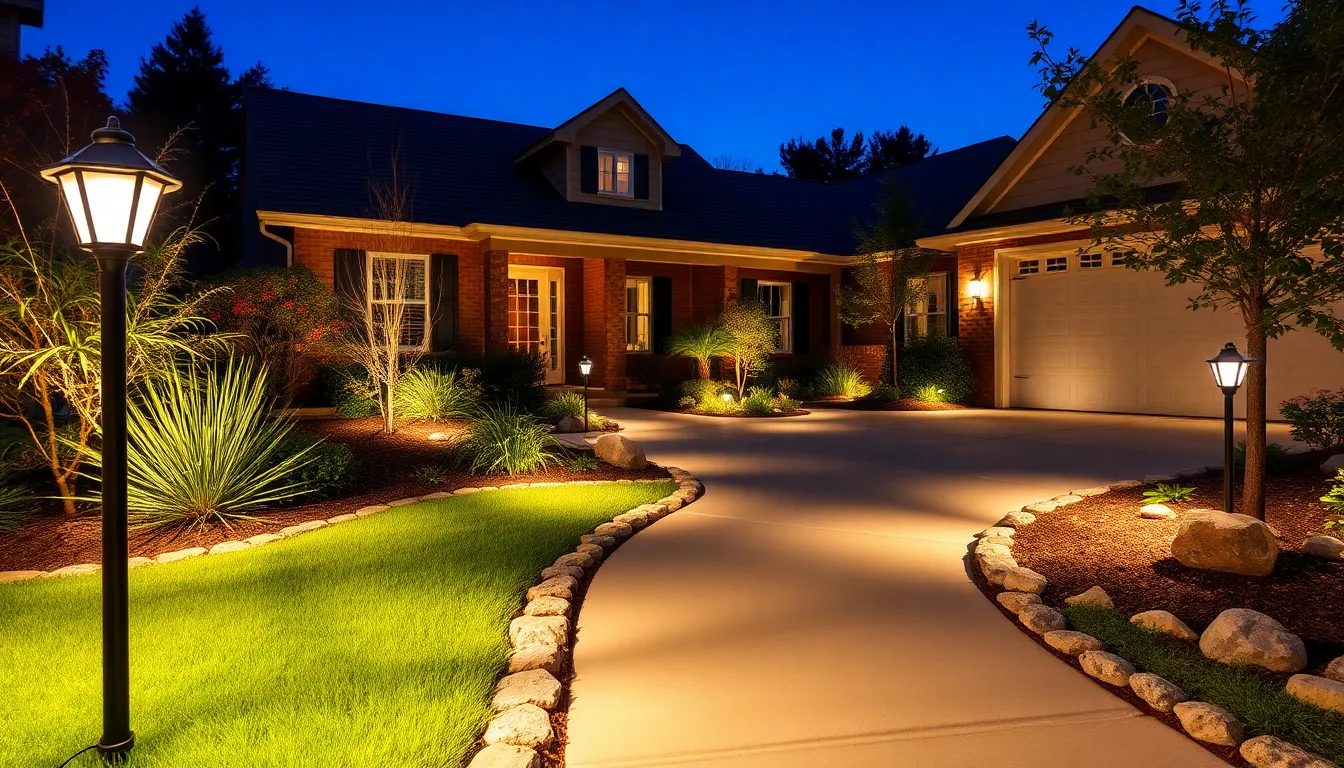
We can transform our front garden with driveway by incorporating strategic lighting answers that enhance both safety and visual appeal. Proper illumination creates an inviting atmosphere while providing essential security for our property.
Install Solar Pathway Lights
Solar pathway lights offer an energy efficient solution for illuminating walkways and driveway borders without increasing electricity costs. These lights automatically charge during daylight hours and provide gentle illumination throughout the evening. We recommend placing them at regular intervals along garden paths to create consistent lighting patterns.
Installation requires no electrical work since solar lights operate independently from our home’s power system. Most models feature weather resistant construction that withstands seasonal changes. We can choose from various styles including modern stainless steel designs or traditional lantern shapes to match our garden’s aesthetic.
Use Accent Lighting on Key Features
Accent lighting highlights exact elements in our front garden such as statues, water features, or architectural plants. Spotlights positioned at ground level can dramatically illuminate specimen trees or decorative elements along the driveway. We should angle these lights carefully to avoid glare while creating stunning visual effects.
LED accent lights consume minimal energy while providing bright focused illumination. Uplighting techniques work particularly well for showcasing ornamental grasses or climbing plants on trellises. We can also use accent lighting to emphasize the decorative edging materials like natural stone or brick that frame our flower beds.
Include Motion Sensor Security Lights
Motion sensor security lights provide essential safety benefits by automatically activating when movement is detected around our driveway area. These lights serve as deterrents for unwanted visitors while ensuring safe navigation during nighttime hours. We should position them strategically near the garage entrance and along the main pathway.
Modern motion sensors offer adjustable sensitivity settings and customizable timer durations to suit our exact needs. LED technology in these fixtures provides bright white light that clearly illuminates the entire driveway surface. We can choose from various mounting options including wall mounted units or post mounted fixtures that integrate seamlessly with our garden design.
Create Seasonal Interest With Strategic Plant Selection
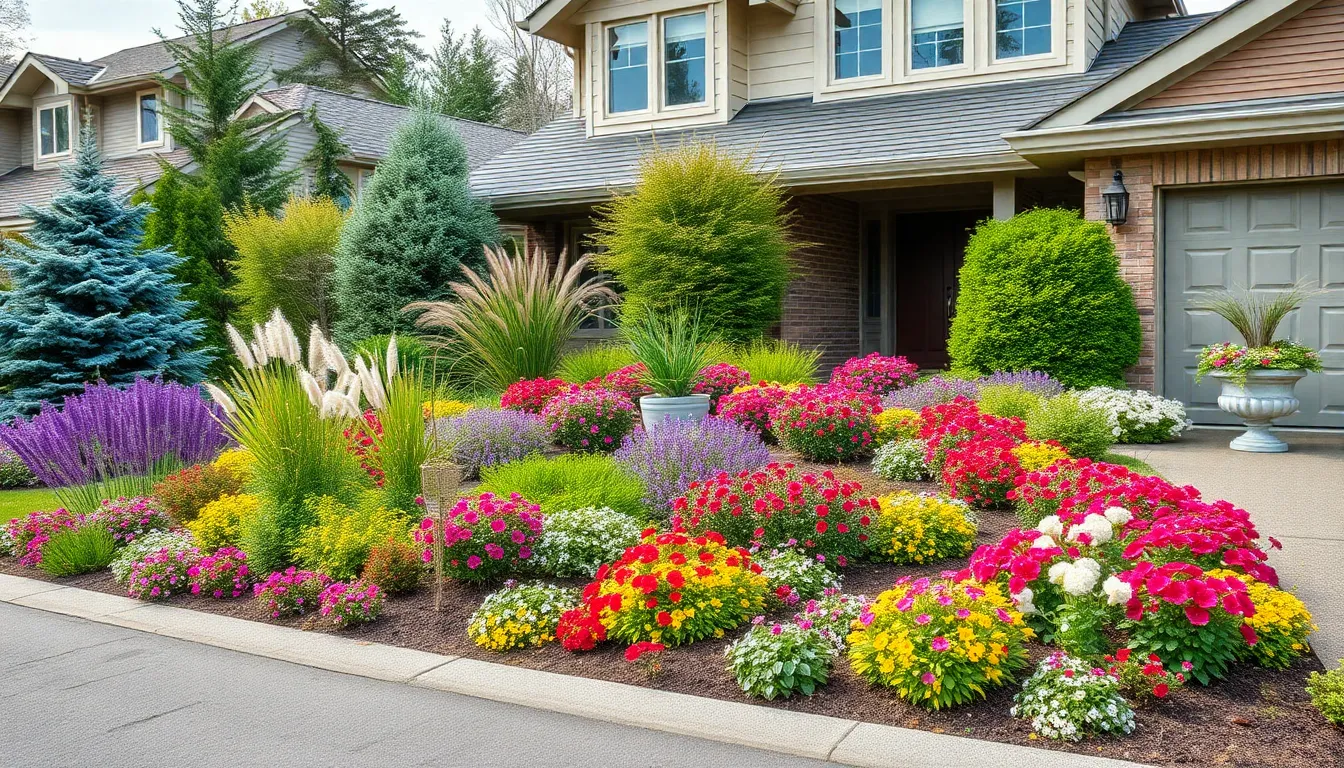
Strategic plant selection transforms our front garden driveway into a ever-changing display that captivates visitors throughout the year. We can achieve continuous visual appeal by carefully choosing plants that bloom at different times and provide year-round structure.
Choose Plants With Year-Round Appeal
Evergreen shrubs form the backbone of our driveway garden design. Holly, boxwood, and juniper provide consistent structure and greenery during winter months when deciduous plants lose their leaves. These hardy options require minimal maintenance while delivering maximum visual impact.
Ornamental grasses add movement and texture to our garden space. Black mondo grass creates dramatic contrast with its dark foliage, while blue oat grass offers silvery tones that complement both modern and traditional driveway designs. These grasses maintain their architectural form throughout most seasons.
Drought tolerant plants reduce maintenance needs while ensuring our garden thrives in challenging conditions. Succulents like sedums and ornamental grasses adapt well to varying water conditions, making them perfect choices for busy homeowners who want beautiful results without constant upkeep.
Plan for Succession Blooming
Spring bulbs kickstart our seasonal display with early color. Tulips, daffodils, and crocuses emerge when winter fades, creating the first wave of vibrant blooms that welcome spring visitors to our home.
Summer flowers maintain momentum with extended blooming periods. Black-eyed susans, coneflowers, and daylilies provide continuous color from early summer through late fall, ensuring our driveway garden never lacks visual interest during peak growing season.
Fall foliage extends our garden’s appeal into autumn months. Asters, chrysanthemums, and ornamental kale deliver rich purples, golds, and deep reds that complement the changing season while maintaining curb appeal as temperatures drop.
Include Evergreen Elements for Winter Structure
Foundation evergreens anchor our garden design when other plants go dormant. We position these plants strategically along driveway edges to maintain visual weight and prevent our garden from appearing bare during winter months.
Decorative planters filled with evergreen arrangements add portable winter interest. These containers allow us flexibility to adjust our garden’s appearance seasonally while providing consistent greenery near high traffic areas like driveway entrances.
Architectural specimen plants serve as focal points throughout winter. Large evergreen shrubs or small ornamental trees create visual anchors that draw the eye and maintain our garden’s sophisticated appearance even when snow covers the ground.
Maximize Small Spaces With Vertical Gardening
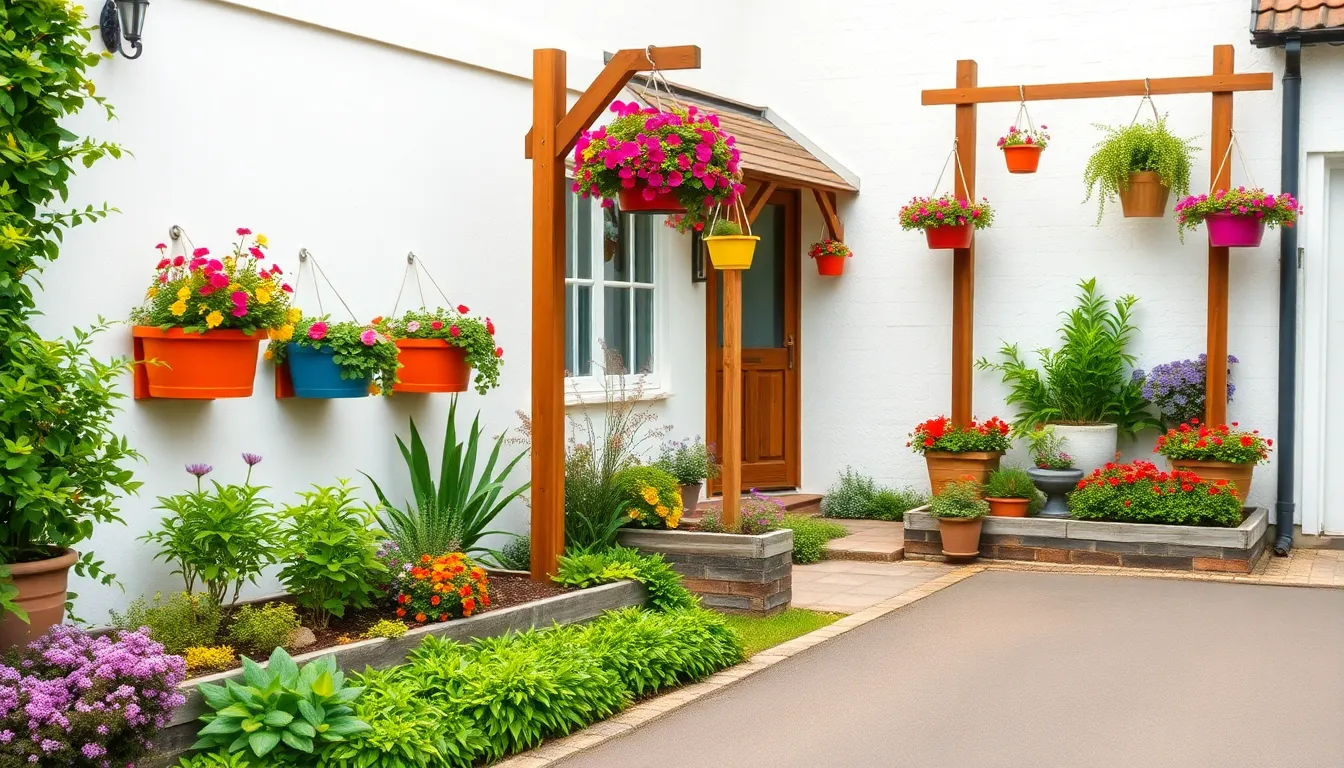
We can transform compact front gardens with driveways by utilizing vertical space to create stunning garden displays. Vertical gardening techniques allow us to achieve maximum visual impact while preserving valuable ground space around our driveway areas.
Use Wall-Mounted Planters
Wall mounted planters offer the perfect solution for adding greenery without sacrificing precious driveway space. We can attach these versatile containers to walls, fences, or garage sides near our driveway entrance to create an instant lush appearance.
Position planters at varying heights to establish visual depth and prevent monotonous arrangements. Strategic placement involves mounting some units higher for cascading plants like trailing petunias or ivy, while lower installations work beautifully for compact flowering plants such as marigolds or impatiens.
Choose planters made from weather resistant materials like metal, composite, or durable plastic that complement our home’s exterior design. We can create cohesive color schemes by selecting planters in neutral tones that won’t compete with our plant selections.
Create Tiered Garden Beds
Tiered garden beds maximize planting opportunities while adding dramatic architectural interest to our driveway landscaping. We can construct multi level displays using stone, brick, or wood materials that create visually appealing landscapes around our driveway perimeter.
Build terraced sections that step down from higher elevations toward the driveway level, allowing each tier to showcase different plant varieties. Lower tiers work perfectly for ground covers like creeping thyme, middle levels accommodate perennial flowers such as black eyed susans, and upper sections provide ideal spots for specimen plants or ornamental grasses.
Design these structures with proper drainage to prevent water accumulation that could damage nearby pavement or foundation areas. We can incorporate decorative edging materials between levels to define each tier clearly and create smooth transitions throughout our vertical garden design.
Install Hanging Baskets on Posts
Hanging baskets suspended from posts deliver instant color and movement to our driveway industry without requiring ground planting space. We can position decorative posts at strategic intervals along our driveway to support colorful basket displays that change seasonally.
Select sturdy posts made from materials like treated wood, metal, or composite that can support multiple baskets while withstanding weather conditions. Post height should allow baskets to hang at eye level for maximum visual impact while maintaining adequate clearance for vehicle access.
Fill baskets with cascading annuals like petunias, trailing verbena, or bacopa for continuous blooms throughout growing seasons. We can rotate seasonal displays by switching spring bulb arrangements for summer flowering plants and later autumn displays featuring ornamental kale or trailing ivy for winter interest.
Blend Hardscaping With Soft Landscaping
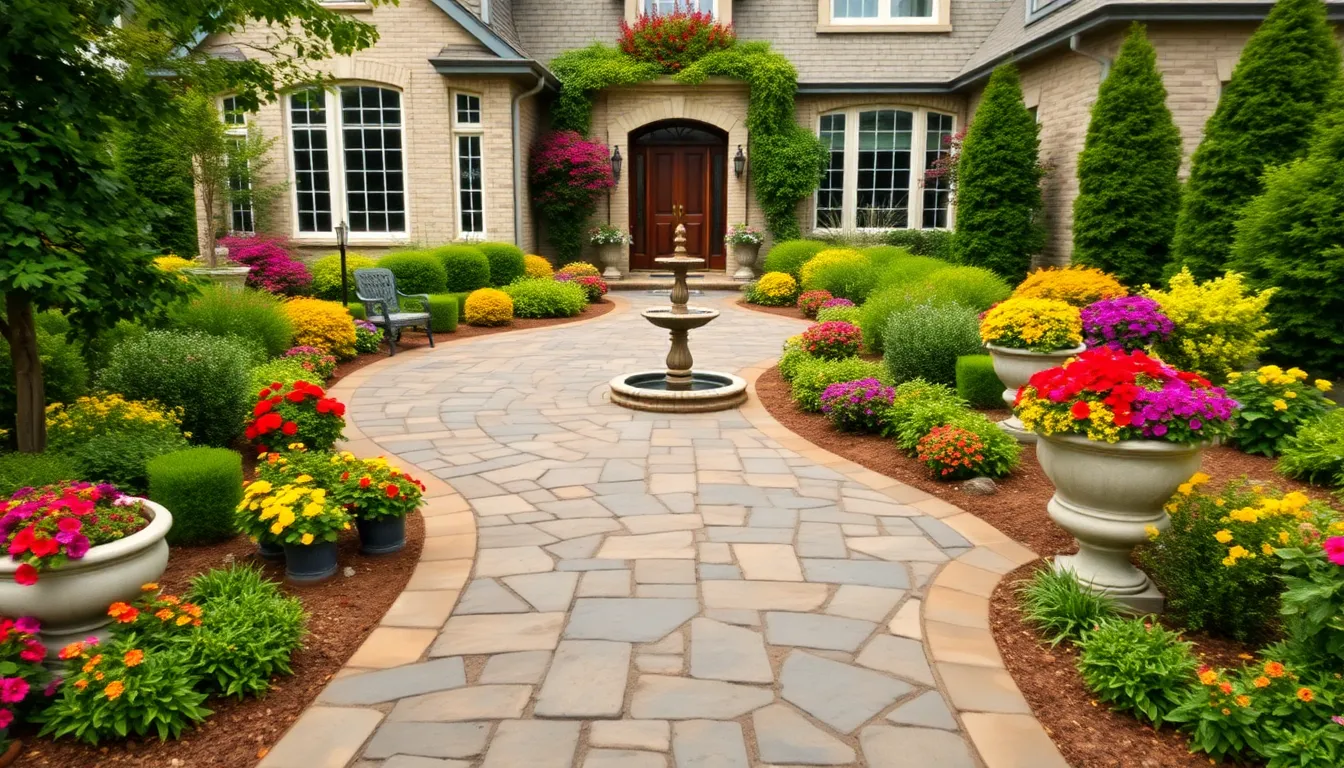
The most successful front garden designs seamlessly combine functional hard surfaces with living elements to create balanced, visually striking spaces. Current design trends emphasize this integration approach, which softens concrete and stone while introducing color, texture, and seasonal interest that enhances overall curb appeal.
Incorporate Stone or Brick Features
Stone driveways paired with surrounding plantings create textured looks that add both structure and permanence to your front garden design. Natural stone materials like flagstone, limestone, and sandstone work exceptionally well when combined with flower beds and shrubs that soften their edges.
Brick pathways complement driveway areas by establishing clear visual connections between different hardscaping elements. We recommend using matching brick for both driveway borders and garden walkways to create design cohesion throughout your front yard space.
Retaining walls made from natural stone serve dual purposes by managing slopes while creating tiered garden beds that add visual depth. These structural elements work particularly well when planted with cascading varieties like ivy, creeping phlox, or trailing sedums that spill over the edges.
Stone or brick edging along driveway perimeters helps define planting areas while preventing soil erosion and plant encroachment onto paved surfaces. Choose materials that complement your home’s exterior to maintain architectural harmony throughout the industry.
Add Water Features as Focal Points
Small fountains positioned strategically near driveway entrances serve as eye-catching accents that bring movement and tranquility to front garden spaces. We suggest selecting fountain sizes that complement rather than overpower your available space while ensuring easy access for maintenance.
Cascading waterfalls integrated into retaining walls or garden slopes create dramatic focal points without requiring extensive ground space. These features work particularly well when surrounded by moisture-loving plants like hostas, ferns, and astilbe that thrive in the humid microclimate.
Decorative water bowls or shallow basins provide subtle water elements that don’t interfere with driveway functionality. Position these features where they’ll catch natural light while remaining visible from both the street and your home’s entrance.
Recirculating water systems ensure your features remain operational year-round while minimizing water waste. We recommend installing timers and seasonal shut-off valves to manage water features efficiently during different weather conditions.
Use Decorative Containers and Planters
Identical shrubs positioned in containers at either side of driveway entrances create symmetrical, welcoming atmospheres that guide visitors naturally toward your home. Choose container sizes that provide adequate root space while maintaining proportional scale with your driveway width.
Matching planters lined along driveway edges establish clear visual borders while adding moveable greenery that you can adjust seasonally. We suggest using weatherproof materials like stone, ceramic, or composite materials that withstand freeze-thaw cycles.
Small trees planted in large containers offer vertical interest without permanent ground commitment, making them perfect for renters or those planning future industry changes. Japanese maples, dwarf fruit trees, and ornamental evergreens work exceptionally well in container settings.
Seasonal container displays allow you to refresh your driveway plantings throughout the year with spring bulbs, summer annuals, fall mums, and winter evergreen arrangements. This approach provides continuous visual appeal while requiring minimal long-term maintenance commitment.
Consider Privacy and Screening Solutions

Creating privacy around your front garden driveway doesn’t mean sacrificing style or functionality. We’ll explore effective screening methods that enhance both security and aesthetic appeal while maintaining the welcoming nature of your entrance.
Plant Fast-Growing Privacy Hedges
Fast growing hedges deliver immediate privacy while establishing natural boundaries around your driveway area. Thuja occidentalis (arborvitae) grows several feet per year and creates dense screening that blocks unwanted views effectively. Leyland cypress offers another excellent option for quick privacy barriers, reaching impressive heights within just a few growing seasons.
These hedge varieties thrive in most soil conditions and require minimal maintenance once established. Plant them in straight rows along property lines or curve them to complement your home’s architecture. Space individual plants 3 to 4 feet apart for optimal growth and coverage density.
Use Decorative Screens or Fencing
Decorative screens provide instant privacy without waiting for plant growth while adding architectural interest to your front garden design. Install free standing trellises to screen neighboring properties while supporting climbing vines like roses or clematis for added beauty. These structures create privacy barriers that don’t obstruct sunlight or completely block visibility.
Curved walls or fences enhance privacy while creating harmonious aesthetics that complement your home’s exterior design. Choose materials like cedar, metal, or composite that match your driveway’s style and existing industry features. Position screens strategically to block exact sight lines while maintaining an open, welcoming atmosphere.
Create Natural Barriers With Large Shrubs
Large shrubs offer versatile privacy answers that can be shaped and maintained to fit your exact screening needs. Boxwood creates dense, structured barriers that respond well to pruning and maintain their shape throughout the seasons. Holly varieties provide year round screening with the added benefit of seasonal berries and glossy foliage.
These natural barriers work particularly well when planted in groups of three or five for maximum visual impact. Maintain shrubs at three feet tall for seating areas to provide sufficient privacy while preserving views of your beautiful front garden. Position larger specimens strategically to block problem views without overwhelming your driveway’s proportions.
Conclusion
Transforming your front garden alongside your driveway doesn’t have to be overwhelming. We’ve shown you that with the right combination of strategic plant selection seasonal interest vertical elements and low-maintenance answers you can create an entrance that’s both beautiful and functional.
The key lies in balancing hardscaping with soft landscaping while incorporating privacy features and proper lighting. Whether you’re working with a small urban space or a larger suburban lot these design principles will help you maximize your garden’s potential.
Your front garden is the first impression visitors get of your home. By implementing these ideas you’ll create a welcoming space that enhances your property value while requiring minimal upkeep throughout the seasons.
Frequently Asked Questions
What are the best plants for creating borders along my driveway?
Low hedging plants like boxwood work excellently for separating gardens from driveways. Lavender borders add aromatic appeal and attract pollinators, while ornamental grasses provide movement and texture throughout all seasons. These plants create natural separators while maintaining visual appeal and requiring minimal maintenance.
How can I create symmetrical plantings around my driveway?
Use matching shrubs on both sides of your driveway to establish visual balance. Evergreen varieties like boxwood and juniper provide year-round structure. Create mirror image flower beds with identical planting schemes on either side, and incorporate geometric shapes like circles and rectangles for added sophistication.
What are the most low-maintenance ground cover options for front gardens?
Drought-tolerant plants like ornamental grasses and evergreen shrubs thrive with minimal water. Ground covers such as creeping thyme and sedum suppress weeds effectively. Decorative gravel and mulch reduce maintenance needs while providing aesthetic appeal. Native species are ideal for their adaptability and low care requirements.
How can I add height and visual interest to my front garden?
Install decorative posts or pillars at key points along your driveway to create focal points. Add climbing plants on trellises like roses and clematis for lush backdrops. Use tall ornamental grasses such as pampas and fountain grass to add texture, movement, and visual depth to your garden design.
What lighting options work best for front gardens with driveways?
Solar pathway lights provide energy-efficient illumination along walkways and are easy to install. Use accent lighting to showcase key garden features like statues and ornamental plants. Motion sensor security lights enhance safety by automatically activating when movement is detected, improving both visibility and security.
How can I create year-round interest in my front garden?
Use evergreen shrubs like holly, boxwood, and juniper for consistent structure. Plan succession blooming with spring bulbs (tulips, daffodils), summer flowers (black-eyed susans, coneflowers), and fall blooms (asters, chrysanthemums). Maintain winter interest with decorative planters and architectural specimen plants.
What are effective privacy solutions for front gardens near driveways?
Plant fast-growing hedges like Thuja occidentalis and Leyland cypress for immediate privacy with minimal maintenance. Install decorative screens and fencing for instant privacy without blocking sunlight. Use large shrubs like boxwood and holly that can be shaped to provide versatile screening while maintaining aesthetic appeal.
How can I maximize small front garden spaces around driveways?
Use wall-mounted planters to add greenery without sacrificing ground space, varying heights for visual depth. Create tiered garden beds for dramatic architectural interest. Install hanging baskets on posts to deliver color and movement without requiring ground planting space, using seasonal displays for continuous appeal.

